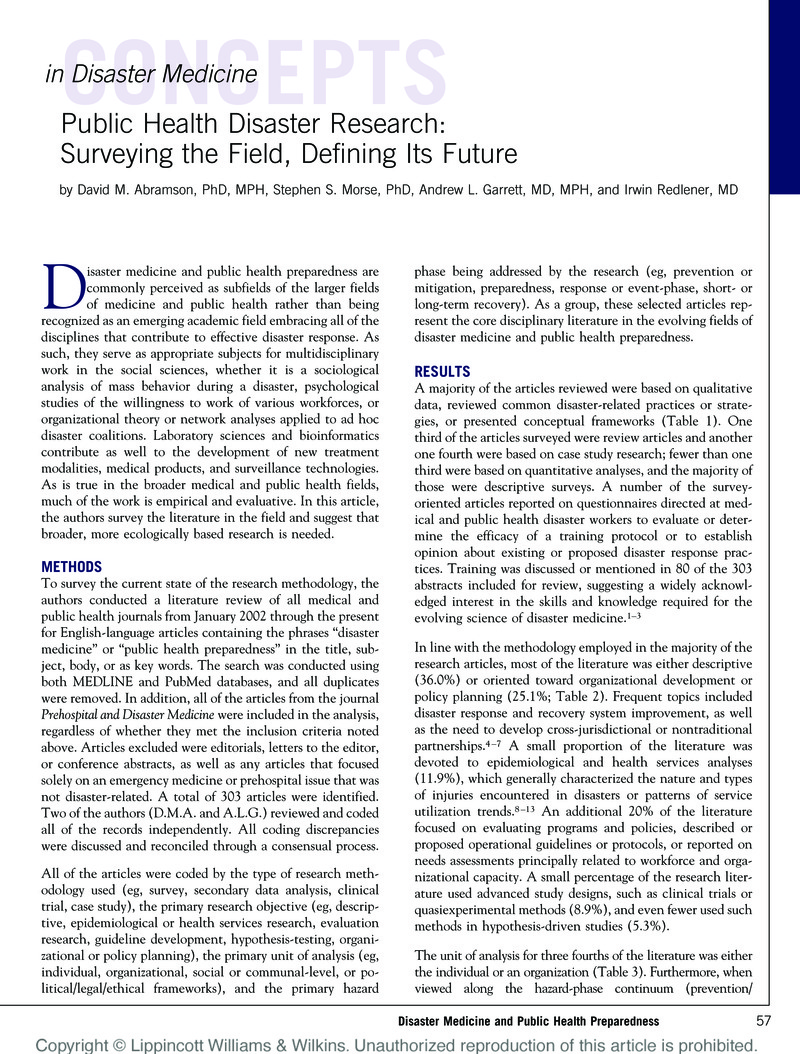Crossref Citations
This article has been cited by the following publications. This list is generated based on data provided by Crossref.
Nelson, Christopher D.
Beckjord, Ellen Burke
Dausey, David J.
Chan, Edward
Lotstein, Debra
and
Lurie, Nicole
2008.
How Can We Strengthen the Evidence Base in Public Health Preparedness?.
Disaster Medicine and Public Health Preparedness,
Vol. 2,
Issue. 4,
p.
247.
Chaffee, Mary
2009.
Willingness of Health Care Personnel to Work in a Disaster: An Integrative Review of the Literature.
Disaster Medicine and Public Health Preparedness,
Vol. 3,
Issue. 1,
p.
42.
Garrett, Andrew L.
Park, Yoon Soo
and
Redlener, Irwin
2009.
Mitigating Absenteeism in Hospital Workers During a Pandemic.
Disaster Medicine and Public Health Preparedness,
Vol. 3,
Issue. S2,
p.
S141.
Savoia, Elena
Massin-Short, Sarah B.
Rodday, Angie Mae
Aaron, Lisa A.
Higdon, Melissa A.
and
Stoto, Michael A.
2009.
Public Health Systems Research in Emergency Preparedness.
American Journal of Preventive Medicine,
Vol. 37,
Issue. 2,
p.
150.
Yeager, Valerie A.
Menachemi, Nir
McCormick, Lisa C.
and
Ginter, Peter M.
2010.
The Nature of the Public Health Emergency Preparedness Literature 2000-2008.
Journal of Public Health Management and Practice,
Vol. 16,
Issue. 5,
p.
441.
Johnson, Jennifer
and
Galea, Sandro
2011.
Resilience and Mental Health.
p.
200.
Schult, Tamara M.
Awosika, Ebi R.
Hodgson, Michael J.
and
Martinello, Richard A.
2011.
2009 Influenza Pandemic Impact on Sick Leave Use in the Veterans Health Administration: Framework for a Health Care Provider–Based National Syndromic Surveillance System.
Disaster Medicine and Public Health Preparedness,
Vol. 5,
Issue. S2,
p.
S235.
Gosney, J E
Reinhardt, J D
von Groote, P M
Rathore, F A
and
Melvin, J L
2013.
Medical rehabilitation of spinal cord injury following earthquakes in rehabilitation resource-scarce settings: implications for disaster research.
Spinal Cord,
Vol. 51,
Issue. 8,
p.
603.
Qari, Shoukat H.
Abramson, David M.
Kushma, Jane A.
and
Halverson, Paul K.
2014.
Preparedness and Emergency Response Research Centers: Early Returns on Investment in Evidence-Based Public Health Systems Research.
Public Health Reports®,
Vol. 129,
Issue. 6_suppl4,
p.
1.
Boyd, Alan
Chambers, Naomi
French, Simon
Shaw, Duncan
King, Russell
and
Whitehead, Alison
2014.
Emergency planning and management in health care: priority research topics.
Health Systems,
Vol. 3,
Issue. 2,
p.
83.
Goldman, Eliot E.
Bauer, Daliah
Newman, Denise L.
Kalka, Elaine
Lochman, John E.
Silverman, Wendy K.
Jensen, Peter S.
Curry, John
Stark, Kevin
Wells, Karen C.
and
Bannon, William M.
2015.
A School-Based Post-Katrina Therapeutic Intervention.
Administration and Policy in Mental Health and Mental Health Services Research,
Vol. 42,
Issue. 3,
p.
363.
Lichtveld, Maureen
Kennedy, Suzanne
Krouse, Rebecca Z.
Grimsley, Faye
El-Dahr, Jane
Bordelon, Keith
Sterling, Yvonne
White, LuAnn
Barlow, Natasha
DeGruy, Shannon
Paul, Dorothy
Denham, Stacey
Hayes, Claire
Sanders, Margaret
Mvula, Mosanda M.
Thornton, Eleanor
Chulada, Patricia
Mitchell, Herman
Martin, William J.
Stephens, Kevin U.
and
Cohn, Richard D.
2016.
From Design to Dissemination: Implementing Community-Based Participatory Research in Postdisaster Communities.
American Journal of Public Health,
Vol. 106,
Issue. 7,
p.
1235.
Gosney, James E.
and
O'Connell, Colleen
2016.
Koenig and Schultz's Disaster Medicine.
p.
376.
Koenig, Kristi L.
Schultz, Carl H.
Gould Runnerstrom, Miryha
and
Ogunseitan, Oladele A.
2017.
Public Health and Disasters: An Emerging Translational and Implementation Science, Not “Lessons Learned”.
Disaster Medicine and Public Health Preparedness,
Vol. 11,
Issue. 5,
p.
610.
Khajehaminian, Mohammad Reza
Ardalan, Ali
Keshtkar, Abbasali
Hosseini Boroujeni, Sayed Mohsen
Nejati, Amir
Ebadati E, Omid Mahdi Ebadati
and
Rahimi Foroushani, Abbas
2018.
A systematic literature review of criteria and models for casualty distribution in trauma related mass casualty incidents.
Injury,
Vol. 49,
Issue. 11,
p.
1959.
Chan, Emily Ying Yang
Hung, Heidi
Murray, Virginia
and
Shaw, Rajib
2020.
Public Health and Disasters.
p.
59.
Haeberer, Mariana
Tsolova, Svetla
Riley, Paul
Cano-Portero, Rosa
Rexroth, Ute
Ciotti, Massimo
and
Fraser, Graham
2021.
Tools for Assessment of Country Preparedness for Public Health Emergencies: A Critical Review.
Disaster Medicine and Public Health Preparedness,
Vol. 15,
Issue. 4,
p.
431.



